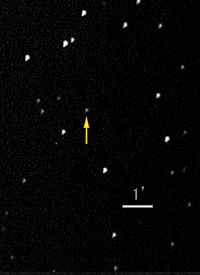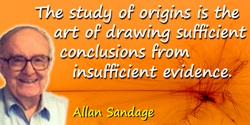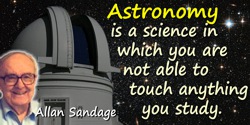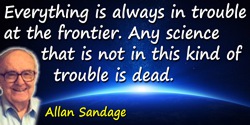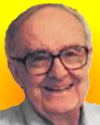 (source)
(source)
|
Allan Rex Sandage
(18 Jun 1926 - 13 Nov 2010)
American astronomer who co-discovered (1960), the first optical identification of a quasi-stellar radio source (quasar), a star-like object that is a strong emitter of radio waves.
|
Allan Rex Sandage
Although interrupted by two years’ service in the Navy during WWII, Allan Sandage finished his batchelor’s degree in physics at the University of Illinois, and then pursued postgraduate study under Walter Baade at the California Institute of Technology to receive his Ph.D. in 1953.
By 1952, Allan Sandage was also a graduate student assistant, on the research staff at the Mt. Wilson and Palomar Observatories, at Pasadena, California. He began his work there under Edwin P. Hubble, the “father of observational cosmology.” Dr. Sandage remained there for the rest of his career, which culminated decades later as Astronomer Emeritus.
Following his mentor’s death in 1953, Sandage continued with Hubble’s passion to study the expansion of the universe. Periodically (with Gustav Tammann), he updated the estimated value of the Hubble constant. Further, Sandage tried to establish a value for the deceleration parameter.
Seeking to determine the age of the oldest objects known, Sandage measured the ages and evolution of globular clusters. He also calibrated the “standard candles” used to establish the distances of remote galaxies. As a result of his continuing efforts in observational cosmology, through the decades, the age of the universe has been measured progressively more and accurately.
In 1960, Dr. Allan Sandage, with his junior colleague, Thomas Matthews, made the first* optical identification of what later became known as a quasar. He had found that there was a faint optical object with an extraordinary spectrum at the position of the compact radio source 3C 48 in the constellation Virgo. This faint quasi-stellar object was emitting more intense radio waves and ultraviolet radiation than a typical star. (Maarten Schmidt subsequently explained (1963) the unusual spectrum as due to a huge red-shift of the hydrogen lines. It had a redshift of 0.367 (about 37%), making it one of the highest redshift sources then known. This suggested the quasar was moving exceptionally fast (30,000 miles per second) and therefore was extremely distant (3 billion light-years away) and luminous as hundreds of galaxies.)
Eventually, Sandage documented many more quasars, finding they are predominantly “radio-quiet” (99%).
Through his long career, Dr. Sandage’s contributions were prolific, following research interests in stellar evolution, observational cosmology, quasars, galaxy formation and galaxy evolution. He published more than four hundred research papers, authored five books, and was Associate Editor of the Annual Review of Astronomy and Astrophysics.
Dr. Sandage was honored with the 1970 President’s National Medal of Science, “For bringing the very limits of the universe within the reach of man’s awareness and unraveling the evolution of stars and galaxies—their origins and ages, distances and destinies.” The medal was presented by President Nixon at a White House Ceremony on 21 May 1971.
Among a number of other awards in his lifetime, Dr. Sandage became a Bruce Medalist in 1975. Catherine Wolfe Bruce established the annual award of a gold medal, for lifetime contributions to astronomy.
On 25 Sep 1991, he was presented a Crafoord Prize at the Royal Swedish Academy. This quadriennial award was established by the Swedish inventor, Holgerd Crafoord, to be astronomy’s equivalent of a Nobel Prize.
Sandage died of pancreatic cancer at age 84, on 13 Nov 2010.
- A photo of Dr. Allan Sandage taken in the early 1970s, inside the dome of the Mount Wilson Observatory, in front of the 100-inch telescope, the instrument first used to establish that the universe was expanding.
- Biographies of Bruce Medalists, including Sandage as the 1975 award winner.
- Realm of the Quasar: coverage of the quasar and related topics of cosmology.
- Science Quotes by Allan Rex Sandage.
- 18 Jun - short biography, births, deaths and events on date of Sandage's birth.
- More for Allan Rex Sandage on Today in Science History page.
